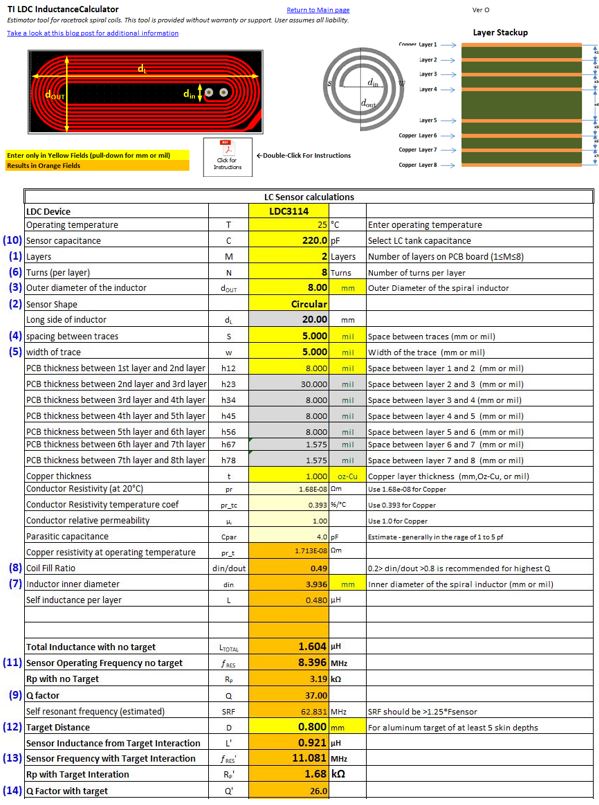SNOAAA5 April 2024 DRV8220 , FDC1004-Q1 , LDC3114-Q1 , TMAG5131-Q1 , TMAG5173-Q1 , TMAG6180-Q1
- 1
- Abstract
- Trademarks
- 1Introduction
- 2Automotive Door Handle Architectures
- 3Functional Demo Design
- 4Detailed Design Flow for Door Handle Functions
- 5Summary
- 6References
4.4.5 Design Example
For this design example, we can assume the button is contained within a dedicated plastic housing, with a PCB and metal tape to provide a target surface. The Inductive Sensing Calculator Tool was used to help determine the coil parameters for this example. Figure 4-28 shows an image of the Spiral_Inductor_Designer tab used for the entries that follow. The numbers ((#)) track the steps and correspond to the numbers in blue font (#) on the left side of Figure 4-28.
- The number of coil PCB layers was assumed to be two, so the tool's Layers field (1) in Figure 4-28 was set to two.
- The Sensor Shape (2) was chosen to Circular
- The Outer diameter of the inductor (3) was set equal to 8mm.
- Spacing between traces(4) and
- Width of trace (5) was set to 5mils
- Turns per layer (6) was set equal to eight.
- These settings result in an Inductor inner diameter (7) slightly less than 4mm with a resulting Coil Fill Ratio (8) (inner diameter divided by outer diameter) of roughly 50%. For most button designs, minimizing the coil fill ratio can provide additional sensitivity but requires the target surface to be very close to the coil for it to be beneficial. Otherwise, it is best to keep the coil fill ratio between 20% and 80% to maximize the Q factor of the design.
- For this design the resulting Q factor (9) is equal to 37 with no target (for example, button surface not present).
- The Sensor capacitance (10) for this sensor design was selected to be 220pF which put the Sensor Operating Frequency no target (11) interaction at 8.396MHz.
- Based on the coil diameter, a (button pressed) Target Distance (12) of 0.8mm away from the coil was selected. This puts the target well within the recommended 3%-20% range of the coil diameter which can give a high sensitivity in response to a force on the button surface.
- As the spreadsheet shows, a Target Distance of 0.8mm results in a Sensor Frequency with Target Interaction (13) of 11.081MHz with a Q factor (14) of 26
The spreadsheet can give a warning if any of the final parameters are out of range for the device, but in this case, no warnings appear.
Note the tool supports many inductive sensors, and the sensors can be selected by the pull-down menu in the LDC Device field. The tool tailors the notifications and warnings to each device's parameters and specs and features.
 Figure 4-28 Inductive Sensing Calculator
Tool - Spiral Inductor Designer tab
Figure 4-28 Inductive Sensing Calculator
Tool - Spiral Inductor Designer tabThe results from the tool are summarized in Table 4-2.
| Description | Designator | Value | Unit |
|---|---|---|---|
| Total Inductance with no target | LTOTAL | 1.604 | µH |
| Sensor Operating Frequency no target | fRES | 8.396 | MHz |
| RP with no Target | RP | 3.19 | kΩ |
| Q factor | Q | 37.00 | |
| Self resonant frequency (estimated) | SRF | 62.831 | MHz |
| Target Distance | D | 0.800 | mm |
| Sensor Inductance from Target Interaction | L' | 0.921 | µH |
| Sensor Frequency with Target Interaction | fRES' | 11.081 | MHz |
| RP with Target Interaction | RP' | 1.68 | kΩ |
| Q Factor with target | Q' | 26.0 |
Since a prototype button design for this design can be 3D printed, the prototype can also include the required spacer for the button design instead of having a separate spacer material as illustrated in Figure 4-29. The standoff and button surfaces are both 1mm thick to provide a surface that has some slight flexibility and to set our target height as desired. Metal tape is then placed inside the button surface between the standoffs so that button surface deflects in the desired area when a force is applied to the button surface. The thickness of the tape then puts the target at about 0.8mm away from the sensor coil.
 Figure 4-29 Inductive Touch Button
Stackup
Figure 4-29 Inductive Touch Button
StackupThe material of the button surface has an impact on how much deflection can occur to the metal target. Materials that are more stiff or that absorb the force can cause less deflection and therefore can require more force for a button press to be detected. This also comes into play when considering the thickness of the button surface. The LDC Calculator Tool Spreadsheet has a tab for determining the deflection of a material if the Young's Modulus and Poisson Ratio are known for the material. Since this design is 3D printed using nylon 12, a deflection of around 20μm is expected for a 2N force applied to the surface. This amount of deflection can be plenty for this button design since the target is so close to the sensor to begin with. See the Inductive Touch System Design Guide for HMI Button Applications, application note for more information on button design.